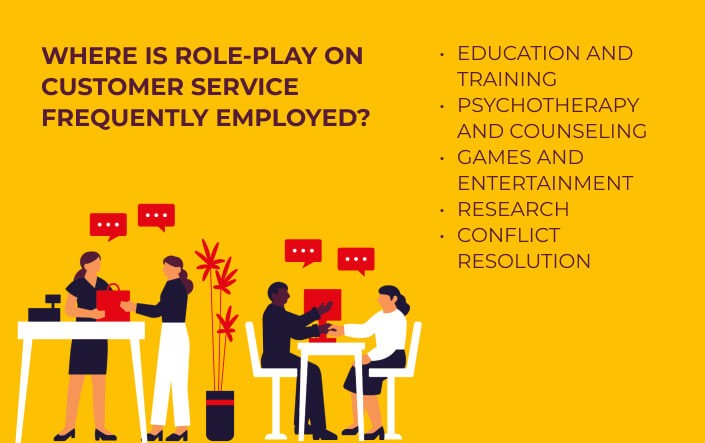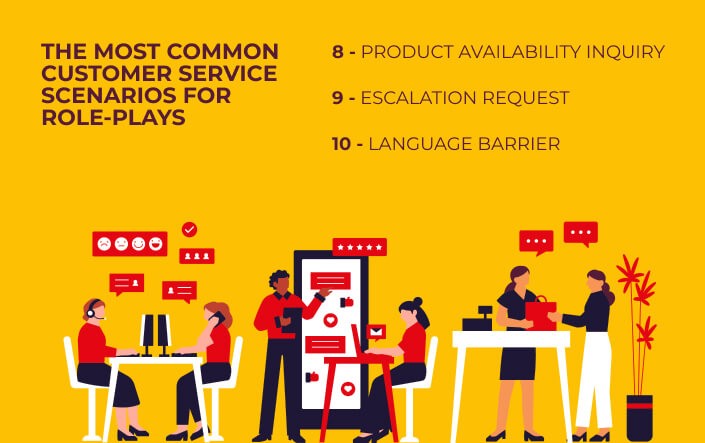Customer service scenarios are pivotal in preparing your staff for various situations that might arise in the business world. Through role–playing, team members can learn how to handle difficult situations and challenging customers, and this can significantly enhance their skills and confidence. This article presents ten comprehensive customer service role–play scenarios to help your employees develop their problem–solving skills and increase their proficiency in customer interactions.
What Are Role–Play Customer Service Scenarios?
Role-playing (RP) scenarios involve structured situations where team members take on different roles, such as customers, support staff, etc. This strategy effectively helps service staff understand customer expectations from a typical customer service encounter. Through these simulated experiences, employees are better equipped to handle unexpected situations with customers and identify areas where they need to improve their knowledge.
Where Is Role–Play on Customer Service Frequently Employed?
Let’s review the areas where customer service RP is the most beneficial:
- Education and Training: Role-playing scenarios are common in teaching and training programs. For example, a role–play scenario in a business training course might involve handling a disgruntled customer or negotiating a business deal. In medical education, students might role–play patient consultations.
- Psychotherapy and Counseling: Therapists may use role–playing to help clients practice coping skills, understand their feelings, or improve social interactions. For instance, a person with social anxiety might role–play a party scenario to manage their tension better.
- Games and Entertainment: Role–playing games (RPGs) are popular entertainment. In these scenarios, players assume the roles of characters in a fictional setting. RPGs can be tabletop games like Dungeons & Dragons, live–action role–playing games (LARPs), or video games like Skyrim or World of Warcraft.
- Research: Role–play can also be used as a research method, especially in social sciences. This approach can help understand how people may act in real–life situations or learn more about decision–making processes.
- Conflict Resolution: Role–playing scenarios can be employed to manage conflicts or to teach conflict management skills. By acting out disagreements, parties can understand the other's perspective.

In these role-playing scenarios, the individuals involved, often guided by rules or guidelines, typically aim to achieve specific objectives within the scenario. By stepping into the shoes of a character or role, individuals can gain a deeper understanding of different perspectives, learn new skills, or explore new behaviors in a safe and structured environment.
Most Common Customer Service Scenarios For Role-plays
To assist you, we'll provide a variety of typical customer service situations and their solutions. This compilation is an excellent initial resource for your business to experiment with role–playing scenarios and observe preliminary outcomes.
Angry Customer
The customer is upset about a product or service, and the agent must address the issue, calm the customer, and find a resolution.
Script
Customer: "This is unacceptable! I am very disappointed with your service!"
Agent: "I'm truly sorry to hear about your experience. I completely understand your frustration. Let's figure out how we can fix this together. Can you tell me more about the issue?"
Faulty Product
The customer has bought a product that doesn’t work as intended. The representative must troubleshoot the issue and provide a solution (such as replacement, refund, or repair).
Script
Customer: "The laptop I bought from you last week won't even turn on!"
Agent: "I'm very sorry to hear about this inconvenience. I understand how frustrating that can be. Could we go through some troubleshooting steps together? If that doesn't work, we'll certainly explore other solutions."
Confused Customer
A customer hardly understands how to use a product or service. The agent must patiently explain the usage or procedure, potentially guiding the customer step-by-step.
Script
Customer: "I just don't understand how to set up this coffee machine!"
Agent: "I can certainly help you with that. Let's walk through the process together. Have you unpacked the machine and plugged it into a power source?"
Request for Refund
A customer is not satisfied with a purchase and wants a refund. The representative should handle the refund process according to the company's policy, ensuring the customer leaves with a positive experience.
Script
Customer: "This product does not meet my expectations at all. I want my money back!"
Agent: "I'm sorry our product didn't meet your expectations. I'd be happy to assist you with your refund. Could I get more information about the product and your order to proceed?"

Billing Dispute
The customer believes they have been overcharged or that there's an error on their bill. The customer service representative should review the bill, verify the problem, and adjust as necessary.
Script
Customer:"My bill is much higher than I expected. There must be a mistake!"
Agent: "I apologize for any confusion and would gladly look into that. Could you please provide me with your account details so I can review your billing information?"
Long Wait Time Complaint
A customer is frustrated about waiting too long for service or delivery. The agent should apologize for the delay, explain the reason (if available), and expedite the service or offer possible alternatives.
Script
Customer: "I have been waiting for half an hour! It is ridiculous!"
Agent: "I'm very sorry for the wait and appreciate your patience. Let's address your concern immediately. How can I assist you today?"
Lost or Delayed Delivery
The customer's product has yet to arrive or is late. The representative needs to track the delivery, provide updates, and resolve the issue (e.g., by resending the product or offering a refund).
Script
Customer: "I still haven't received my order. Where is it?"
Agent: "I'm sorry for the delay. Let's check your order status together. Could you please provide your order number?"

Product Availability Inquiry
A customer is inquiring about the availability of a product currently out of stock. The representative has to provide information about when the product will be available or suggest alternative products.
Script
Customer: "I've been looking for this book for ages, and it's always out of stock. When will you have it?"
Agent: "I understand your eagerness to get this book. I'll do my best to provide an accurate timeline for its availability, or if possible, suggest a similar title you might enjoy."
Escalation Request
The customer has not been satisfied with the responses so far and asked to speak to a manager. The representative must handle the situation delicately, trying to solve the problem while respecting the customer's wishes
Script
Customer: "I'm not happy with your responses. I want to talk to your manager."
Agent: "I'm sorry to hear that you're not satisfied. It's my goal to help you. However, I do respect your request. Allow me a moment to connect you with my manager."

Final Word About Customer Service Role–play Scenarios
The question concerning customer expectations in a typical customer service interaction is straightforward — they desire exceptional service. The key to delivering this lies in diligent work, arranging educational sessions, and practicing customer service scenarios. The proficiency of your employees is vital for your business.
Competent employees can attract new customers, maintain existing ones, and infuse vitality into the organization. Training your staff is an investment in human resources leading to higher profit and a well–built brand identity.


